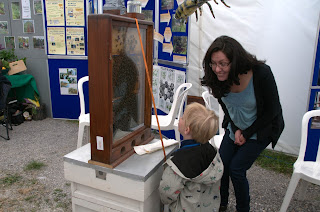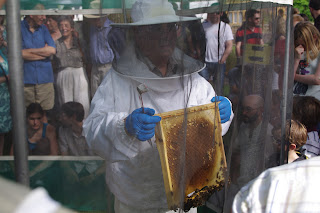Last month Alex and Rhiannon wrote about the
ballast seed collection at the Botanic Garden and hinted at a new project, called “Seeds of Change: Growing a Living History of Bristol”. The
Seeds of Change project provides Bristol schools and community groups with an opportunity to grow ballast seed gardens of their own and link the plants that they grow to the maritime history that is integral to Bristol’s heritage.
The partners on this project, the University of Bristol’s
Centre for Public Engagement,
Botanic Garden, and
Arnolfini have all been working hard on different aspects of the project to prepare for its launch, including developing creative workshops in partnership with artists and academics, building relationships with schools and community groups, sorting out the logistics of planting ballast seed gardens all over the city, and recruiting a troop of student volunteers to go out into the community and help build the gardens. The project is well underway and I recently joined the student volunteers on a training session at the Botanic Garden as they prepared to head out to the schools and community groups.
The day’s training covered everything from advice on how to draw out the many themes of the Seeds of Change project and managing enthusiastic school children to tips on turning soil. However, like all good training, there was a practical component that allowed the volunteers the opportunity to get their hands dirty and pick up some great tips from the staff at the Botanic Garden at the same time!
Avoiding the ‘Tom and Jerry’ style of tool storage
 |
Botanic Garden Curator, Nick Wray
explains tool safety. |
After a brief introduction to the day by Seeds of Change Coordinator
Martha Crean, and Botanic Garden Curator Nick Wray, the volunteers were divided into two groups. I followed Nick’s group out to the vegetable patch where they were to practice preparing a bed and sowing seed.
After the volunteers put down their gardening tools and gathered around, Nick starts with some basic health and safety. He points to rakes left in what he refers to as the ‘Tom and Jerry’ style. I’m sure you can picture it – stand on the upturned teeth of the rake and the handle springs up to crack you in the nose in a perfectly choreographed slap-stick comedy sketch. Only it’s not slap-stick and it’s school children rather than a cartoon cat and mouse.
Nick masterfully divides and designates, showing how to handle groups by example and taking the volunteers through every step that they will need to do when they go out to their schools and community groups. The volunteers range in gardening experience and so Nick doesn’t miss a single detail, explaining how to handle the tools without breaking your back, how to prepare soil that has been turned and broken down to just the perfect particle size, and even how to clean your boots when you’re done.
There are also tips about keeping school children engaged and busy. After he uses the draw hoe to mark out a furrow in the ground that marks the border where they will be planting, Nick says, “Now, you and I can see that but a child won’t. They’ll step right over it.” As a mother, I can immediately see his point, but I wouldn’t have thought of it had he not mentioned it. He suggests that the volunteers keep the children busy by getting them to collect pebbles or sticks to lie in the furrow and mark out the planting bed. Simple, but an effective way of keeping everyone engaged with the project.
Nick even manages to work in discussions of evolution as he points out that most of the seed is dark against the soil in order to avoid predation. These are tidbits of information that I would be storing for later if I were one of the volunteers.
And in the potting shed…
 |
Froggie works with Seeds of Change
volunteer Alex in the potting shed. |
With Nick’s group all busy sowing seeds, I decide to head back to the potting shed to see what Froggie’s group is doing in the potting shed. I walk in and it’s very quiet and the volunteers are all very busy filling small pots with soil, placing the pots in large trays and using other pots to level the soil, then planting the seeds, watering and placing the trays outside. I’ve unfortunately missed the instructional part.
Some of the community groups and schools won’t have garden space, and so they will instead be doing some container gardening with their ballast seeds. The volunteers will have to be prepared for both situations.
Student volunteers share an interest in gardening and children
For the volunteers, Seeds of Change offers a wonderful opportunity to be involved in a city wide project that ties gardening in with themes related to art, history and science, while also building their skill set and network for the future.
While there are many benefits on paper to volunteering, I decided to chat with a number of the volunteers to find out what really brought them away from their studies and research to play in the dirt on a sunny March day.
 |
| Seeds of Change volunteers sowing ballast seed in pots. |
When I approached Camilla, a second year undergraduate student in Biological Sciences, she was busy breaking down clumps of dirt with a rake in the Garden’s vegetable patch. Camilla worked at the Botanic Garden last year and really enjoyed it, so when the email about the Seeds of Change opportunity hit her Inbox she embraced the opportunity, “I was looking for something to do outside of my studies, but still related,” said Camilla. “It’s a chance to give something back while still learning.”
On the way to the potting shed, I walked with two plant ecology PhD students who are also volunteering for the project. After joking that the project would be a good distraction from their research, they admitted that it was the idea of growing gardens with children that appealed to them.
In the potting shed, Alex, a History of Art student, was busy patting down soil in little pots to provide an even surface for sowing the seeds. Alex is thinking about going into teaching and found the aspect of working with children appealing, but also comes from a family of gardeners and in her words, “is quite used to messing about in the dirt”.
For others, like Nicola, another History of Art student, it was the prospect of making contacts and working with Arnolfini that drew her into the project.
Next steps for the volunteers
 |
Seeds of Change volunteers turning soil, preparing for
when they will help schools and community groups plant
ballast seed gardens all over Bristol. |
After the day of training at the Botanic Garden, the volunteers are going out to the site location that they’ve been assigned to with Kasha Smal , who is both a horticulturalist and former primary school teacher. Kasha has helped produce a workshop program for the Seeds of Change project directed at years 4, 5 and 6 (keystage 2). The workshop includes a 30-minute activity as well as 30-minutes of thinking about the origins of the plants and places they might know as well as uses of the plants. Kasha will then introduce the idea of planting the ballast seed garden and introduce the volunteer. The volunteers will take the opportunity to assess what the garden situation is – pots versus a plot, well-worked soil versus needs some work, tools on hand.
After the introductory session, the volunteers will return to their groups on their own and plant the gardens. Then, a few weeks later, they will do a follow-up session to see how things are getting on and maybe take the opportunity to talk more about the plants that have germinated and link them to the themes of the Seeds of Change project.
Ballast seed garden is only one strand of the project
The project is ambitious. Gardening is only one component of the project as each of these groups will also do a creative workshop alongside the ballast seed garden. There are three workshops to choose from and each one combines an artist and an academic working on some aspect of the Seeds of Change project. When Martha explained each of the workshops to me, the one that caught my attention investigates the sounds of plants and involves a sound artist as well as a scientist. The idea is to explore the sounds you hear when you put a microphone up to a plant and investigate the biological processes that underlie those sounds. That is most certainly the subject of a future blog post!
There will be a website that will be associated with the Seeds of Change project, and each of the 16 ballast seed gardens being built around the city will have a page within that website with pictures and anecdotes documenting their experiences. I’ll be sure to follow how the project is progressing and report back with news of how the volunteers are getting on.
The Seeds of Change project is still in need of some volunteers, so if you’re interested, please contact Martha Crean at 0117 33 18313 or martha.crean@bristol.ac.uk.













